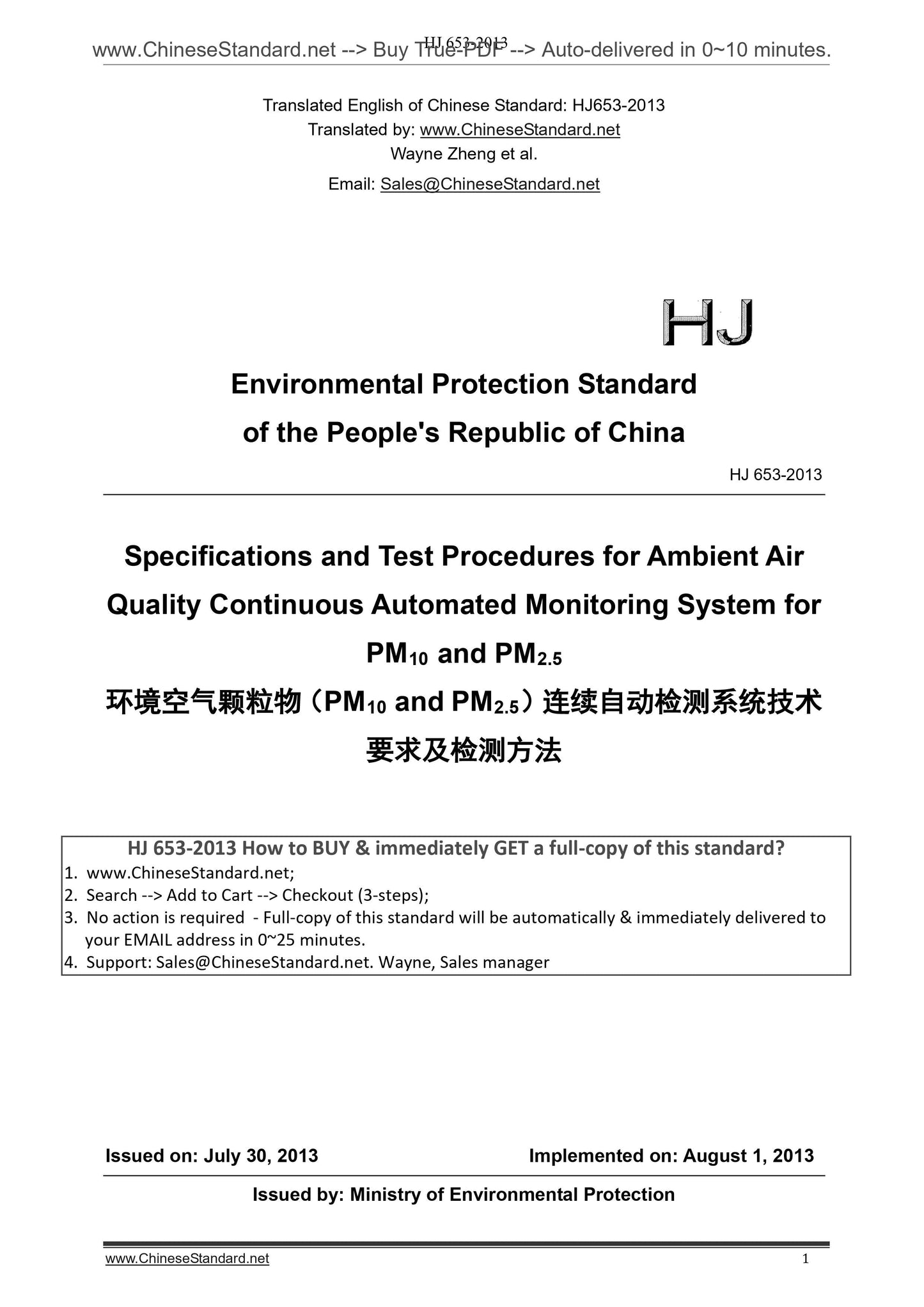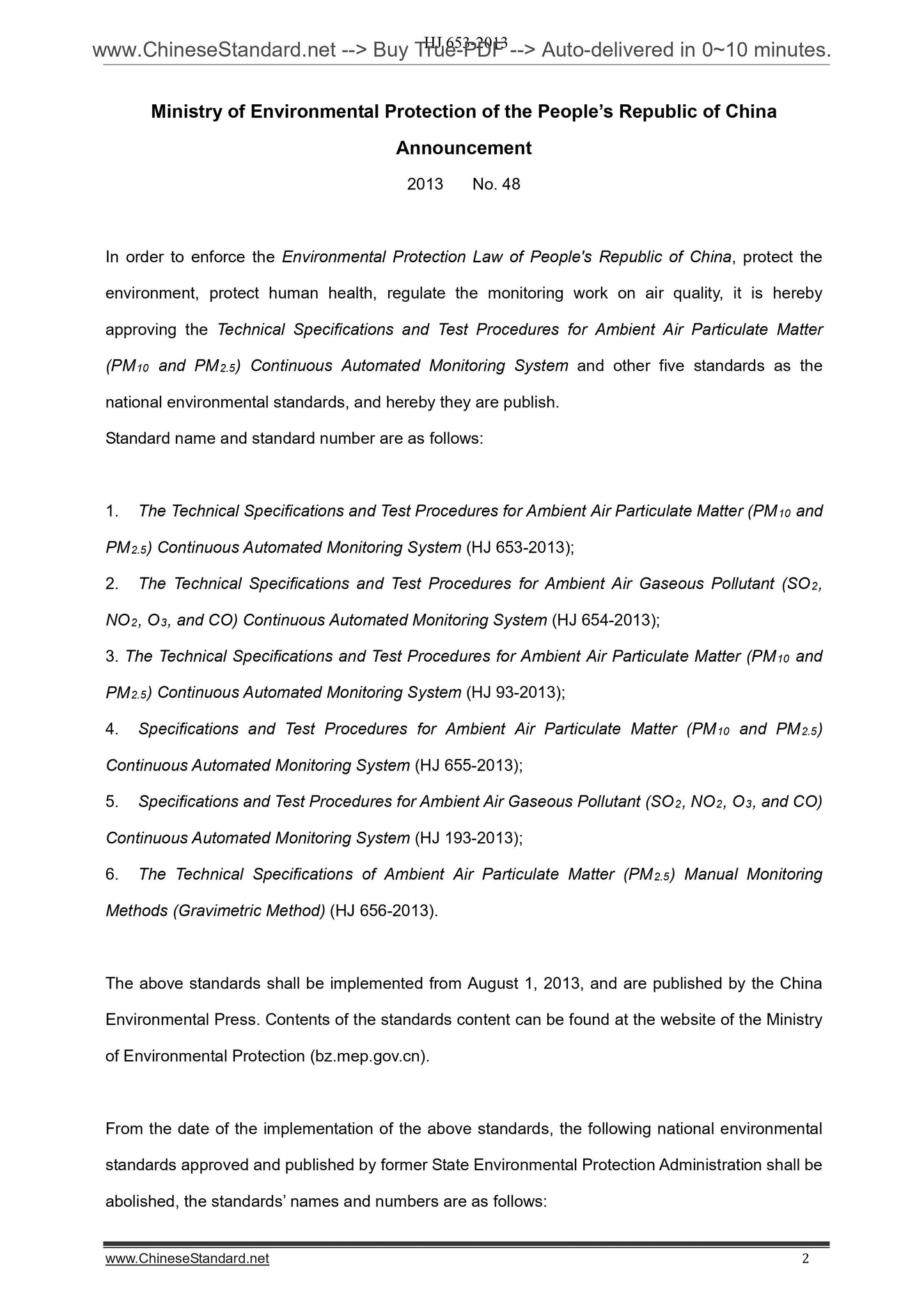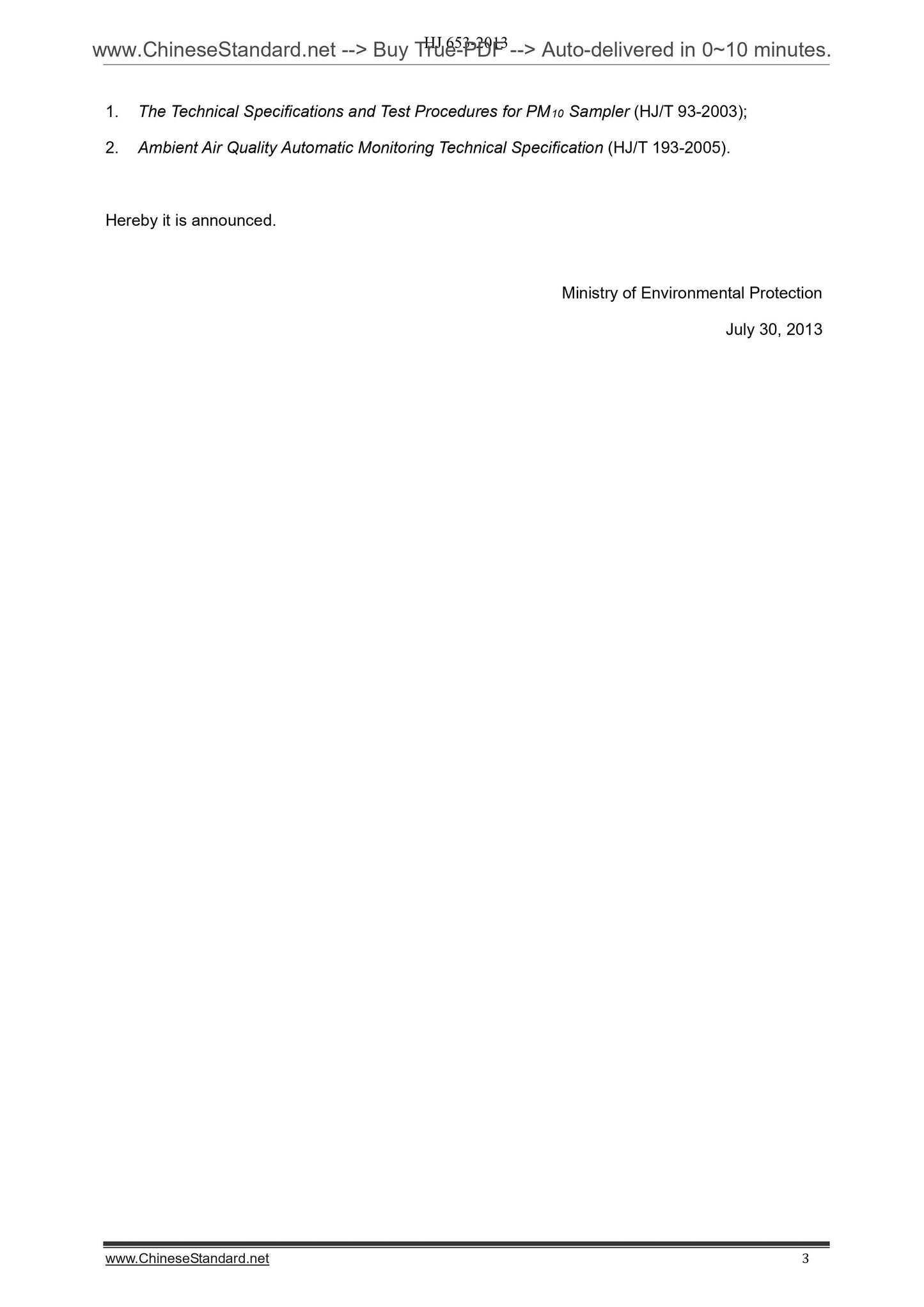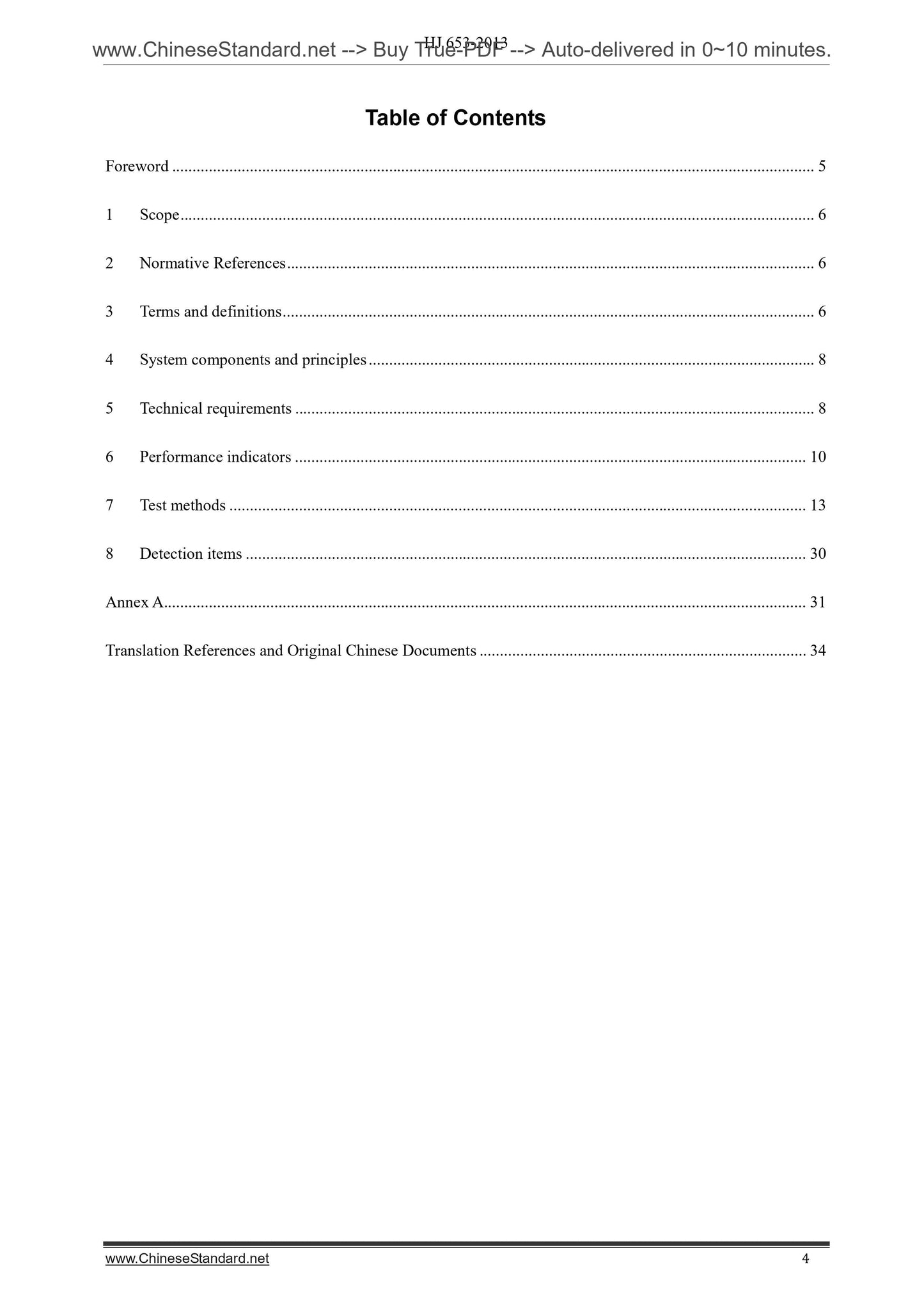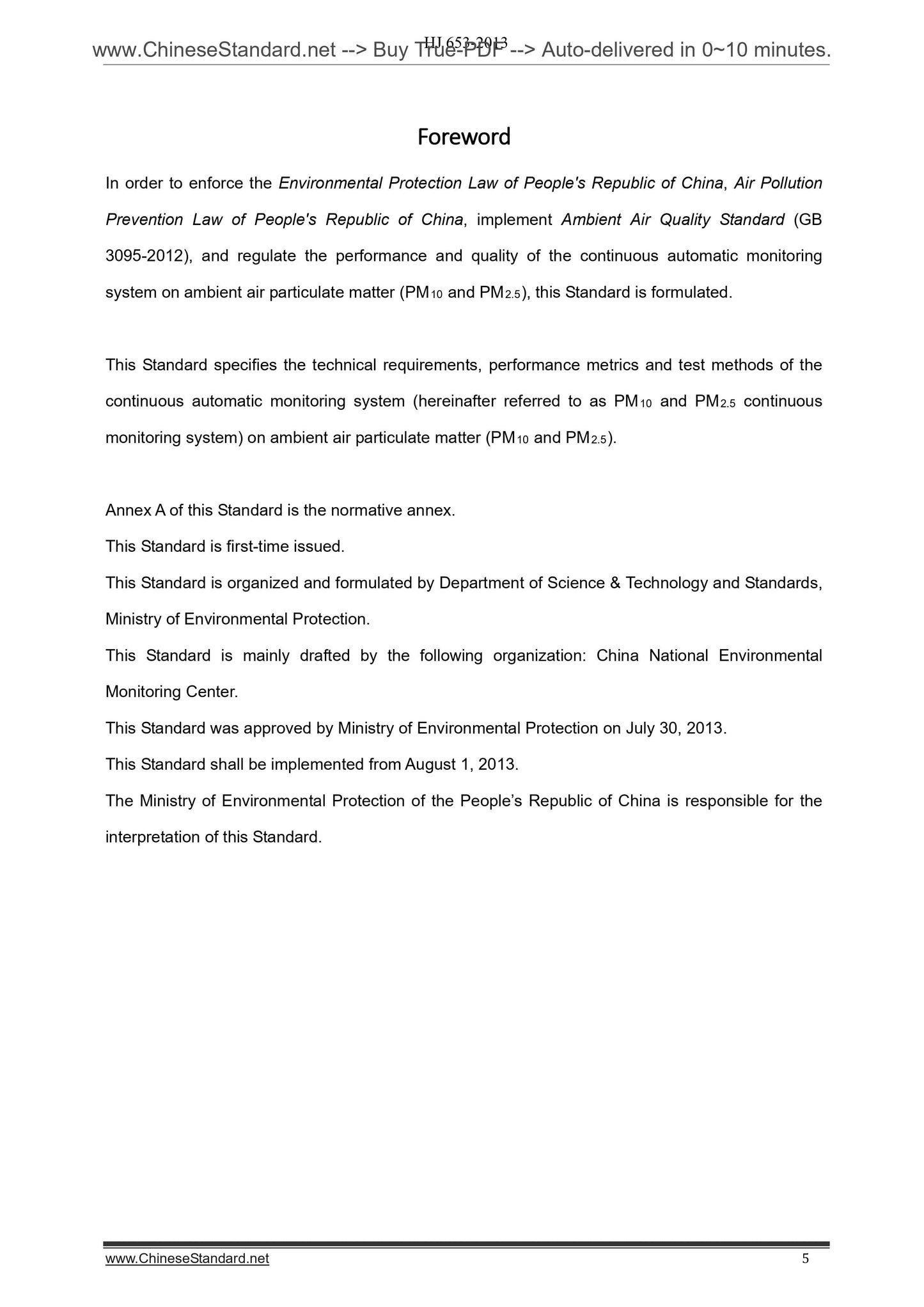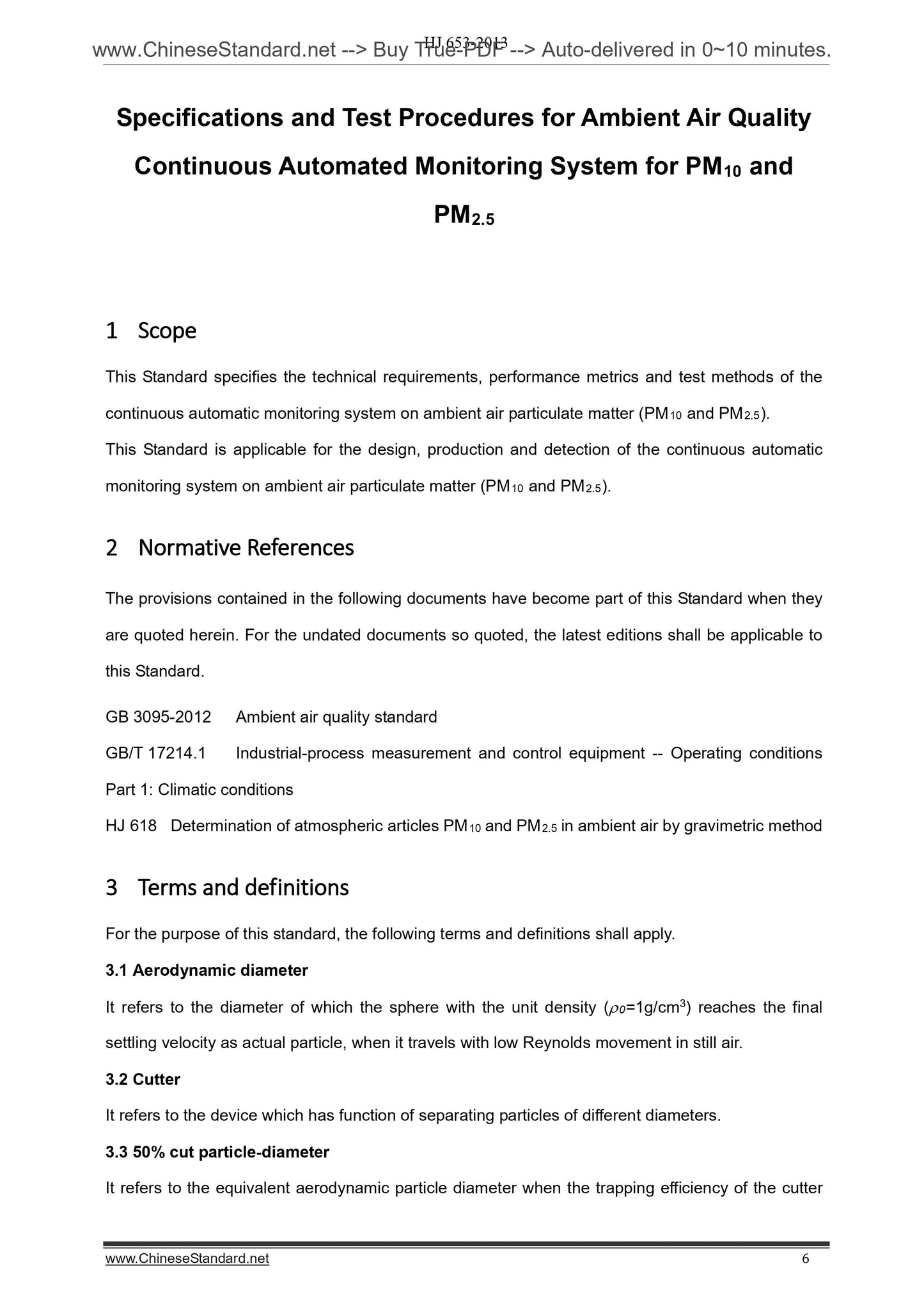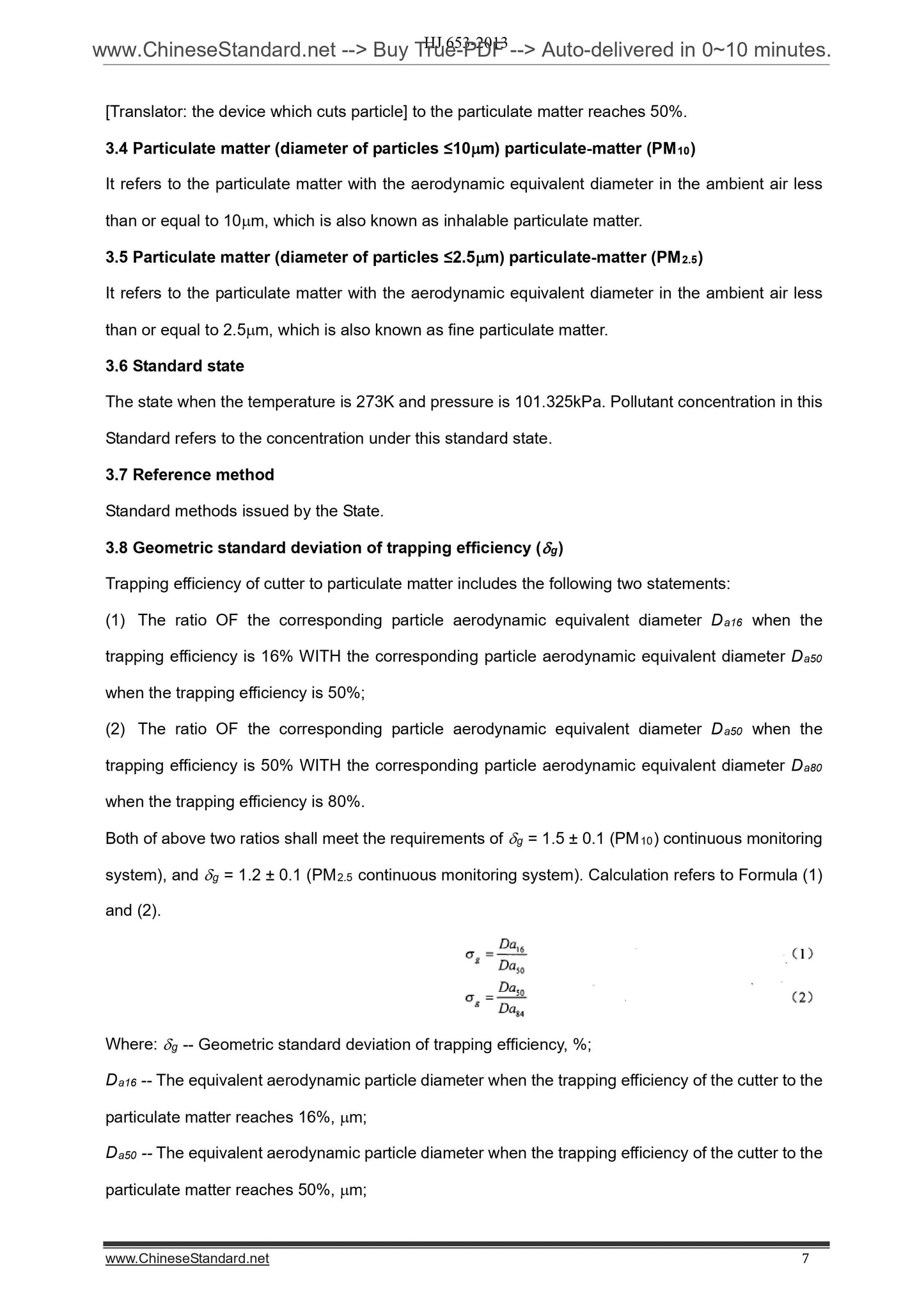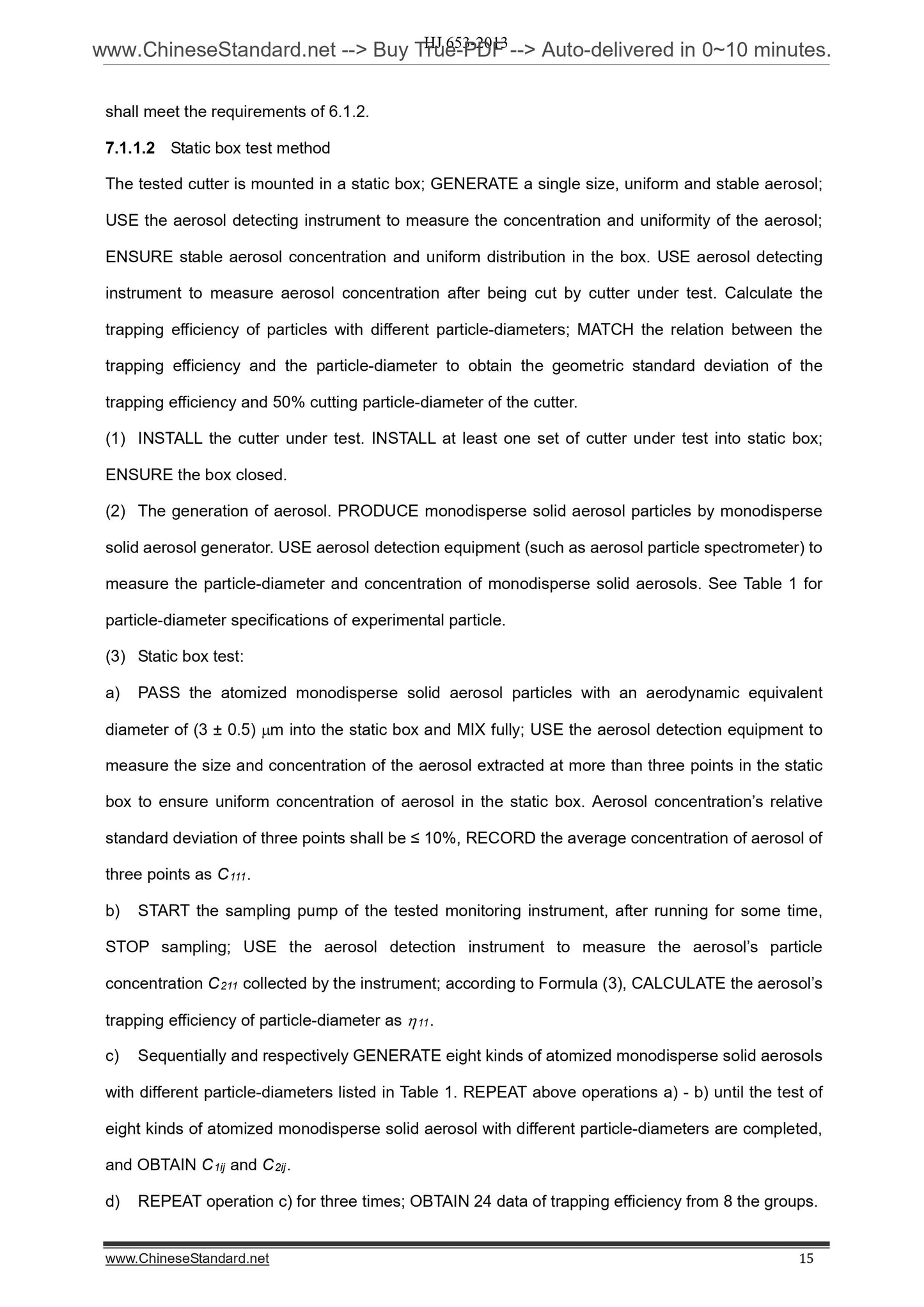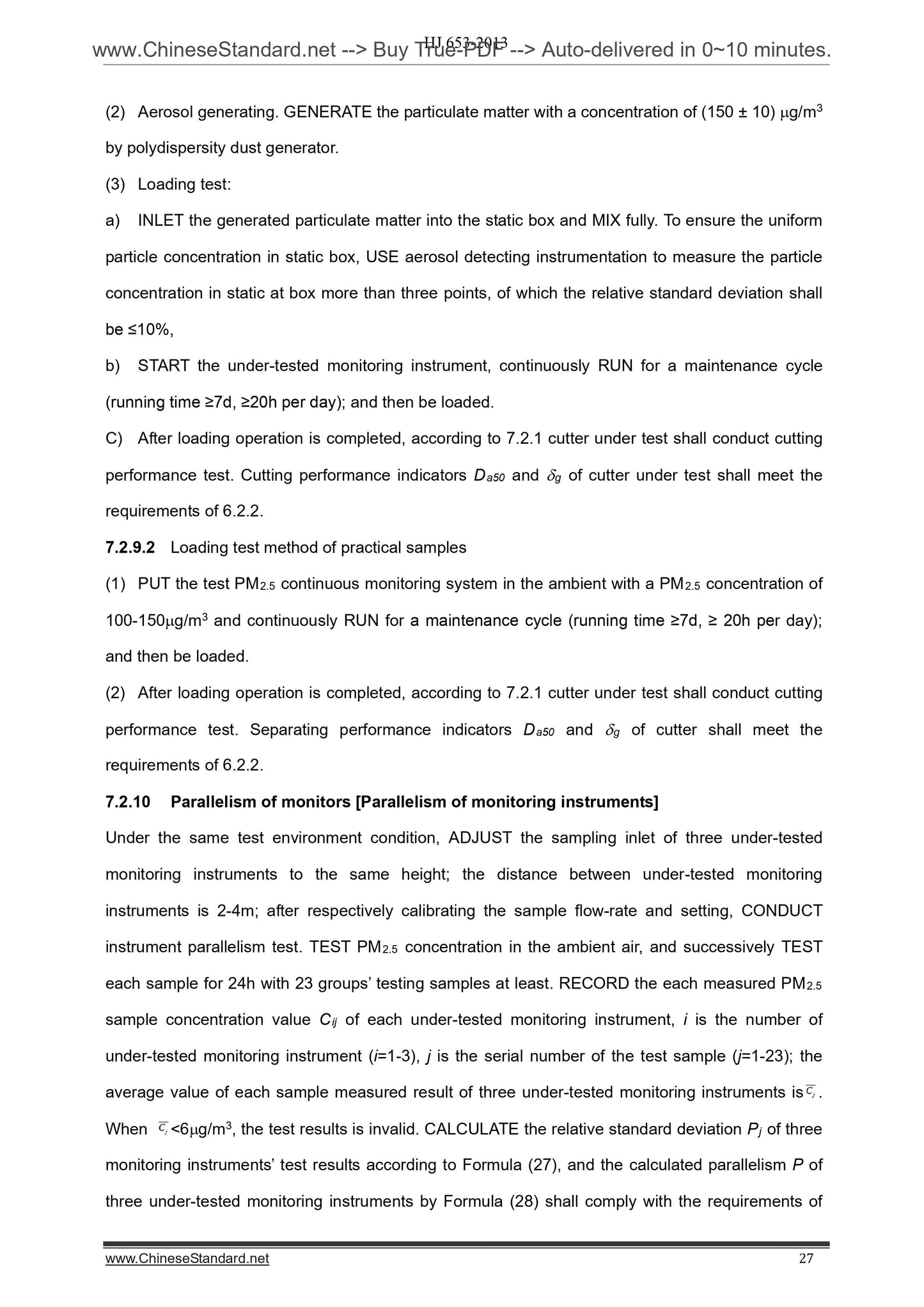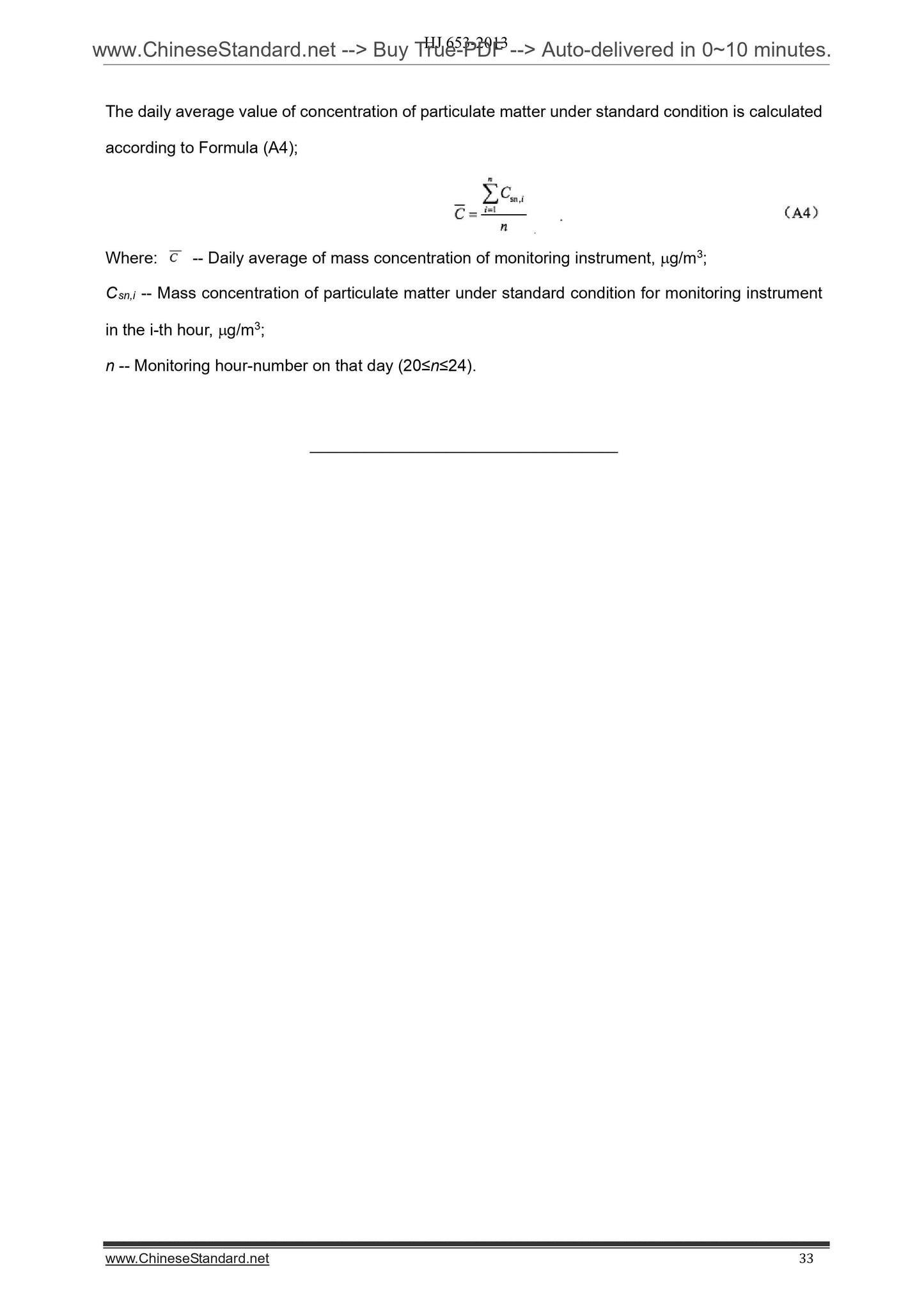1
/
of
11
www.ChineseStandard.us -- Field Test Asia Pte. Ltd.
HJ 653-2013 English PDF
HJ 653-2013 English PDF
Regular price
$230.00
Regular price
Sale price
$230.00
Unit price
/
per
Shipping calculated at checkout.
Couldn't load pickup availability
HJ 653-2013: Specifications and Test Procedures for Ambient Air Quality Continuous Automated Monitoring System for PM10 and PM2 - 5
Delivery: 9 seconds. Download (& Email) true-PDF + Invoice.
Get Quotation: Click HJ 653-2013 (Self-service in 1-minute)
Historical versions (Master-website): HJ 653-2013
Preview True-PDF (Reload/Scroll-down if blank)
HJ 653-2013
Environmental Protection Standard
of the People's Republic of China
Specifications and Test Procedures for Ambient Air
Quality Continuous Automated Monitoring System for
PM10 and PM2.5
ISSUED ON. JULY 30, 2013
IMPLEMENTED ON. AUGUST 1, 2013
Issued by. Ministry of Environmental Protection
Ministry of Environmental Protection of the People’s Republic of China
Announcement
2013 No. 48
In order to enforce the Environmental Protection Law of People's Republic of China, protect the
environment, protect human health, regulate the monitoring work on air quality, it is hereby
approving the Technical Specifications and Test Procedures for Ambient Air Particulate Matter
(PM10 and PM2.5) Continuous Automated Monitoring System and other five standards as the
national environmental standards, and hereby they are publish.
Standard name and standard number are as follows.
1. The Technical Specifications and Test Procedures for Ambient Air Particulate Matter (PM10 and
PM2.5) Continuous Automated Monitoring System (HJ 653-2013);
2. The Technical Specifications and Test Procedures for Ambient Air Gaseous Pollutant (SO2,
NO2, O3, and CO) Continuous Automated Monitoring System (HJ 654-2013);
3. The Technical Specifications and Test Procedures for Ambient Air Particulate Matter (PM10 and
PM2.5) Continuous Automated Monitoring System (HJ 93-2013);
4. Specifications and Test Procedures for Ambient Air Particulate Matter (PM10 and PM2.5)
Continuous Automated Monitoring System (HJ 655-2013);
5. Specifications and Test Procedures for Ambient Air Gaseous Pollutant (SO2, NO2, O3, and CO)
Continuous Automated Monitoring System (HJ 193-2013);
6. The Technical Specifications of Ambient Air Particulate Matter (PM2.5) Manual Monitoring
Methods (Gravimetric Method) (HJ 656-2013).
The above standards shall be implemented from August 1, 2013, and are published by the China
Environmental Press. Contents of the standards content can be found at the website of the Ministry
of Environmental Protection (bz.mep.gov.cn).
From the date of the implementation of the above standards, the following national environmental
standards approved and published by former State Environmental Protection Administration shall be
abolished, the standards’ names and numbers are as follows.
1. The Technical Specifications and Test Procedures for PM10 Sampler (HJ/T 93-2003);
2. Ambient Air Quality Automatic Monitoring Technical Specification (HJ/T 193-2005).
Hereby it is announced.
Ministry of Environmental Protection
July 30, 2013
Table of Contents
Foreword ... 5
1 Scope ... 6
2 Normative References ... 6
3 Terms and definitions ... 6
4 System components and principles ... 8
5 Technical requirements ... 8
6 Performance indicators ... 10
7 Test methods ... 13
8 Detection items ... 30
Annex A... 31
Translation References and Original Chinese Documents ... 34
Foreword
In order to enforce the Environmental Protection Law of People's Republic of China, Air Pollution
Prevention Law of People's Republic of China, implement Ambient Air Quality Standard (GB
3095-2012), and regulate the performance and quality of the continuous automatic monitoring
system on ambient air particulate matter (PM10 and PM2.5), this Standard is formulated.
This Standard specifies the technical requirements, performance metrics and test methods of the
continuous automatic monitoring system (hereinafter referred to as PM10 and PM2.5 continuous
monitoring system) on ambient air particulate matter (PM10 and PM2.5).
Annex A of this Standard is the normative annex.
This Standard is first-time issued.
This Standard is organized and formulated by Department of Science and Technology and Standards,
Ministry of Environmental Protection.
This Standard is mainly drafted by the following organization. China National Environmental
Monitoring Center.
This Standard was approved by Ministry of Environmental Protection on July 30, 2013.
This Standard shall be implemented from August 1, 2013.
The Ministry of Environmental Protection of the People’s Republic of China is responsible for the
interpretation of this Standard.
Specifications and Test Procedures for Ambient Air Quality
Continuous Automated Monitoring System for PM10 and
PM2.5
1 Scope
This Standard specifies the technical requirements, performance metrics and test methods of the
continuous automatic monitoring system on ambient air particulate matter (PM10 and PM2.5).
This Standard is applicable for the design, production and detection of the continuous automatic
monitoring system on ambient air particulate matter (PM10 and PM2.5).
2 Normative References
The provisions contained in the following documents have become part of this Standard when they
are quoted herein. For the undated documents so quoted, the latest editions shall be applicable to
this Standard.
GB 3095-2012 Ambient air quality standard
GB/T 17214.1 Industrial-process measurement and control equipment -- Operating conditions
Part 1. Climatic conditions
HJ 618 Determination of atmospheric articles PM10 and PM2.5 in ambient air by gravimetric method
3 Terms and definitions
For the purpose of this standard, the following terms and definitions shall apply.
3.1 Aerodynamic diameter
It refers to the diameter of which the sphere with the unit density (ρ0=1g/cm3) reaches the final
settling velocity as actual particle, when it travels with low Reynolds movement in still air.
3.2 Cutter
It refers to the device which has function of separating particles of different diameters.
3.3 50% cut particle-diameter
It refers to the equivalent aerodynamic particle diameter when the trapping efficiency of the cutter
[Translator. the device which cuts particle] to the particulate matter reaches 50%.
3.4 Particulate matter (diameter of particles ≤10µm) particulate-matter (PM10)
It refers to the particulate matter with the aerodynamic equivalent diameter in the ambient air less
than or equal to 10µm, which is also known as inhalable particulate matter.
3.5 Particulate matter (diameter of particles ≤2.5µm) particulate-matter (PM2.5)
It refers to the particulate matter with the aerodynamic equivalent diameter in the ambient air less
than or equal to 2.5µm, which is also known as fine particulate matter.
3.6 Standard state
The state when the temperature is 273K and pressure is 101.325kPa. Pollutant concentration in this
Standard refers to the concentration under this standard state.
3.7 Reference method
Standard methods issued by the State.
3.8 Geometric standard deviation of trapping efficiency (δg)
Trapping efficiency of cutter to particulate matter includes the following two statements.
(1) The ratio OF the corresponding particle aerodynamic equivalent diameter Da16 when the
trapping efficiency is 16% WITH the corresponding particle aerodynamic equivalent diameter Da50
when the trapping efficiency is 50%;
(2) The ratio OF the corresponding particle aerodynamic equivalent diameter Da50 when the
trapping efficiency is 50% WITH the corresponding particle aerodynamic equivalent diameter Da80
when the trapping efficiency is 80%.
Both of above two ratios shall meet the requirements of δg = 1.5 ± 0.1 (PM10) continuous monitoring
system), and δg = 1.2 ± 0.1 (PM2.5 continuous monitoring system). Calculation refers to Formula (1)
and (2).
Where. δg -- Geometric standard deviation of trapping efficiency, %;
Da16 -- The equivalent aerodynamic particle diameter when the trapping efficiency of the cutter to the
particulate matter reaches 16%, µm;
Da50 -- The equivalent aerodynamic particle diameter when the trapping efficiency of the cutter to the
particulate matter reaches 50%, µm;
shall meet the requirements of 6.1.2.
7.1.1.2 Static box test method
The tested cutter is mounted in a static box; GENERATE a single size, uniform and stable aerosol;
USE the aerosol detecting instrument to measure the concentration and uniformity of the aerosol;
ENSURE stable aerosol concentration and uniform distribution in the box. USE aerosol detecting
instrument to measure aerosol concentration after being cut by cutter under test. Calculate the
trapping efficiency of particles with different particle-diameters; MATCH the relation between the
trapping efficiency and the particle-diameter to obtain the geometric standard deviation of the
trapping eff...
HJ 653-2013
Environmental Protection Standard
of the People's Republic of China
Specifications and Test Procedures for Ambient Air
Quality Continuous Automated Monitoring System for
PM10 and PM2.5
ISSUED ON. JULY 30, 2013
IMPLEMENTED ON. AUGUST 1, 2013
Issued by. Ministry of Environmental Protection
Ministry of Environmental Protection of the People’s Republic of China
Announcement
2013 No. 48
In order to enforce the Environmental Protection Law of People's Republic of China, protect the
environment, protect human health, regulate the monitoring work on air quality, it is hereby
approving the Technical Specifications and Test Procedures for Ambient Air Particulate Matter
(PM10 and PM2.5) Continuous Automated Monitoring System and other five standards as the
national environmental standards, and hereby they are publish.
Standard name and standard number are as follows.
1. The Technical Specifications and Test Procedures for Ambient Air Particulate Matter (PM10 and
PM2.5) Continuous Automated Monitoring System (HJ 653-2013);
2. The Technical Specifications and Test Procedures for Ambient Air Gaseous Pollutant (SO2,
NO2, O3, and CO) Continuous Automated Monitoring System (HJ 654-2013);
3. The Technical Specifications and Test Procedures for Ambient Air Particulate Matter (PM10 and
PM2.5) Continuous Automated Monitoring System (HJ 93-2013);
4. Specifications and Test Procedures for Ambient Air Particulate Matter (PM10 and PM2.5)
Continuous Automated Monitoring System (HJ 655-2013);
5. Specifications and Test Procedures for Ambient Air Gaseous Pollutant (SO2, NO2, O3, and CO)
Continuous Automated Monitoring System (HJ 193-2013);
6. The Technical Specifications of Ambient Air Particulate Matter (PM2.5) Manual Monitoring
Methods (Gravimetric Method) (HJ 656-2013).
The above standards shall be implemented from August 1, 2013, and are published by the China
Environmental Press. Contents of the standards content can be found at the website of the Ministry
of Environmental Protection (bz.mep.gov.cn).
From the date of the implementation of the above standards, the following national environmental
standards approved and published by former State Environmental Protection Administration shall be
abolished, the standards’ names and numbers are as follows.
1. The Technical Specifications and Test Procedures for PM10 Sampler (HJ/T 93-2003);
2. Ambient Air Quality Automatic Monitoring Technical Specification (HJ/T 193-2005).
Hereby it is announced.
Ministry of Environmental Protection
July 30, 2013
Table of Contents
Foreword ... 5
1 Scope ... 6
2 Normative References ... 6
3 Terms and definitions ... 6
4 System components and principles ... 8
5 Technical requirements ... 8
6 Performance indicators ... 10
7 Test methods ... 13
8 Detection items ... 30
Annex A... 31
Translation References and Original Chinese Documents ... 34
Foreword
In order to enforce the Environmental Protection Law of People's Republic of China, Air Pollution
Prevention Law of People's Republic of China, implement Ambient Air Quality Standard (GB
3095-2012), and regulate the performance and quality of the continuous automatic monitoring
system on ambient air particulate matter (PM10 and PM2.5), this Standard is formulated.
This Standard specifies the technical requirements, performance metrics and test methods of the
continuous automatic monitoring system (hereinafter referred to as PM10 and PM2.5 continuous
monitoring system) on ambient air particulate matter (PM10 and PM2.5).
Annex A of this Standard is the normative annex.
This Standard is first-time issued.
This Standard is organized and formulated by Department of Science and Technology and Standards,
Ministry of Environmental Protection.
This Standard is mainly drafted by the following organization. China National Environmental
Monitoring Center.
This Standard was approved by Ministry of Environmental Protection on July 30, 2013.
This Standard shall be implemented from August 1, 2013.
The Ministry of Environmental Protection of the People’s Republic of China is responsible for the
interpretation of this Standard.
Specifications and Test Procedures for Ambient Air Quality
Continuous Automated Monitoring System for PM10 and
PM2.5
1 Scope
This Standard specifies the technical requirements, performance metrics and test methods of the
continuous automatic monitoring system on ambient air particulate matter (PM10 and PM2.5).
This Standard is applicable for the design, production and detection of the continuous automatic
monitoring system on ambient air particulate matter (PM10 and PM2.5).
2 Normative References
The provisions contained in the following documents have become part of this Standard when they
are quoted herein. For the undated documents so quoted, the latest editions shall be applicable to
this Standard.
GB 3095-2012 Ambient air quality standard
GB/T 17214.1 Industrial-process measurement and control equipment -- Operating conditions
Part 1. Climatic conditions
HJ 618 Determination of atmospheric articles PM10 and PM2.5 in ambient air by gravimetric method
3 Terms and definitions
For the purpose of this standard, the following terms and definitions shall apply.
3.1 Aerodynamic diameter
It refers to the diameter of which the sphere with the unit density (ρ0=1g/cm3) reaches the final
settling velocity as actual particle, when it travels with low Reynolds movement in still air.
3.2 Cutter
It refers to the device which has function of separating particles of different diameters.
3.3 50% cut particle-diameter
It refers to the equivalent aerodynamic particle diameter when t...
Delivery: 9 seconds. Download (& Email) true-PDF + Invoice.
Get Quotation: Click HJ 653-2013 (Self-service in 1-minute)
Historical versions (Master-website): HJ 653-2013
Preview True-PDF (Reload/Scroll-down if blank)
HJ 653-2013
Environmental Protection Standard
of the People's Republic of China
Specifications and Test Procedures for Ambient Air
Quality Continuous Automated Monitoring System for
PM10 and PM2.5
ISSUED ON. JULY 30, 2013
IMPLEMENTED ON. AUGUST 1, 2013
Issued by. Ministry of Environmental Protection
Ministry of Environmental Protection of the People’s Republic of China
Announcement
2013 No. 48
In order to enforce the Environmental Protection Law of People's Republic of China, protect the
environment, protect human health, regulate the monitoring work on air quality, it is hereby
approving the Technical Specifications and Test Procedures for Ambient Air Particulate Matter
(PM10 and PM2.5) Continuous Automated Monitoring System and other five standards as the
national environmental standards, and hereby they are publish.
Standard name and standard number are as follows.
1. The Technical Specifications and Test Procedures for Ambient Air Particulate Matter (PM10 and
PM2.5) Continuous Automated Monitoring System (HJ 653-2013);
2. The Technical Specifications and Test Procedures for Ambient Air Gaseous Pollutant (SO2,
NO2, O3, and CO) Continuous Automated Monitoring System (HJ 654-2013);
3. The Technical Specifications and Test Procedures for Ambient Air Particulate Matter (PM10 and
PM2.5) Continuous Automated Monitoring System (HJ 93-2013);
4. Specifications and Test Procedures for Ambient Air Particulate Matter (PM10 and PM2.5)
Continuous Automated Monitoring System (HJ 655-2013);
5. Specifications and Test Procedures for Ambient Air Gaseous Pollutant (SO2, NO2, O3, and CO)
Continuous Automated Monitoring System (HJ 193-2013);
6. The Technical Specifications of Ambient Air Particulate Matter (PM2.5) Manual Monitoring
Methods (Gravimetric Method) (HJ 656-2013).
The above standards shall be implemented from August 1, 2013, and are published by the China
Environmental Press. Contents of the standards content can be found at the website of the Ministry
of Environmental Protection (bz.mep.gov.cn).
From the date of the implementation of the above standards, the following national environmental
standards approved and published by former State Environmental Protection Administration shall be
abolished, the standards’ names and numbers are as follows.
1. The Technical Specifications and Test Procedures for PM10 Sampler (HJ/T 93-2003);
2. Ambient Air Quality Automatic Monitoring Technical Specification (HJ/T 193-2005).
Hereby it is announced.
Ministry of Environmental Protection
July 30, 2013
Table of Contents
Foreword ... 5
1 Scope ... 6
2 Normative References ... 6
3 Terms and definitions ... 6
4 System components and principles ... 8
5 Technical requirements ... 8
6 Performance indicators ... 10
7 Test methods ... 13
8 Detection items ... 30
Annex A... 31
Translation References and Original Chinese Documents ... 34
Foreword
In order to enforce the Environmental Protection Law of People's Republic of China, Air Pollution
Prevention Law of People's Republic of China, implement Ambient Air Quality Standard (GB
3095-2012), and regulate the performance and quality of the continuous automatic monitoring
system on ambient air particulate matter (PM10 and PM2.5), this Standard is formulated.
This Standard specifies the technical requirements, performance metrics and test methods of the
continuous automatic monitoring system (hereinafter referred to as PM10 and PM2.5 continuous
monitoring system) on ambient air particulate matter (PM10 and PM2.5).
Annex A of this Standard is the normative annex.
This Standard is first-time issued.
This Standard is organized and formulated by Department of Science and Technology and Standards,
Ministry of Environmental Protection.
This Standard is mainly drafted by the following organization. China National Environmental
Monitoring Center.
This Standard was approved by Ministry of Environmental Protection on July 30, 2013.
This Standard shall be implemented from August 1, 2013.
The Ministry of Environmental Protection of the People’s Republic of China is responsible for the
interpretation of this Standard.
Specifications and Test Procedures for Ambient Air Quality
Continuous Automated Monitoring System for PM10 and
PM2.5
1 Scope
This Standard specifies the technical requirements, performance metrics and test methods of the
continuous automatic monitoring system on ambient air particulate matter (PM10 and PM2.5).
This Standard is applicable for the design, production and detection of the continuous automatic
monitoring system on ambient air particulate matter (PM10 and PM2.5).
2 Normative References
The provisions contained in the following documents have become part of this Standard when they
are quoted herein. For the undated documents so quoted, the latest editions shall be applicable to
this Standard.
GB 3095-2012 Ambient air quality standard
GB/T 17214.1 Industrial-process measurement and control equipment -- Operating conditions
Part 1. Climatic conditions
HJ 618 Determination of atmospheric articles PM10 and PM2.5 in ambient air by gravimetric method
3 Terms and definitions
For the purpose of this standard, the following terms and definitions shall apply.
3.1 Aerodynamic diameter
It refers to the diameter of which the sphere with the unit density (ρ0=1g/cm3) reaches the final
settling velocity as actual particle, when it travels with low Reynolds movement in still air.
3.2 Cutter
It refers to the device which has function of separating particles of different diameters.
3.3 50% cut particle-diameter
It refers to the equivalent aerodynamic particle diameter when the trapping efficiency of the cutter
[Translator. the device which cuts particle] to the particulate matter reaches 50%.
3.4 Particulate matter (diameter of particles ≤10µm) particulate-matter (PM10)
It refers to the particulate matter with the aerodynamic equivalent diameter in the ambient air less
than or equal to 10µm, which is also known as inhalable particulate matter.
3.5 Particulate matter (diameter of particles ≤2.5µm) particulate-matter (PM2.5)
It refers to the particulate matter with the aerodynamic equivalent diameter in the ambient air less
than or equal to 2.5µm, which is also known as fine particulate matter.
3.6 Standard state
The state when the temperature is 273K and pressure is 101.325kPa. Pollutant concentration in this
Standard refers to the concentration under this standard state.
3.7 Reference method
Standard methods issued by the State.
3.8 Geometric standard deviation of trapping efficiency (δg)
Trapping efficiency of cutter to particulate matter includes the following two statements.
(1) The ratio OF the corresponding particle aerodynamic equivalent diameter Da16 when the
trapping efficiency is 16% WITH the corresponding particle aerodynamic equivalent diameter Da50
when the trapping efficiency is 50%;
(2) The ratio OF the corresponding particle aerodynamic equivalent diameter Da50 when the
trapping efficiency is 50% WITH the corresponding particle aerodynamic equivalent diameter Da80
when the trapping efficiency is 80%.
Both of above two ratios shall meet the requirements of δg = 1.5 ± 0.1 (PM10) continuous monitoring
system), and δg = 1.2 ± 0.1 (PM2.5 continuous monitoring system). Calculation refers to Formula (1)
and (2).
Where. δg -- Geometric standard deviation of trapping efficiency, %;
Da16 -- The equivalent aerodynamic particle diameter when the trapping efficiency of the cutter to the
particulate matter reaches 16%, µm;
Da50 -- The equivalent aerodynamic particle diameter when the trapping efficiency of the cutter to the
particulate matter reaches 50%, µm;
shall meet the requirements of 6.1.2.
7.1.1.2 Static box test method
The tested cutter is mounted in a static box; GENERATE a single size, uniform and stable aerosol;
USE the aerosol detecting instrument to measure the concentration and uniformity of the aerosol;
ENSURE stable aerosol concentration and uniform distribution in the box. USE aerosol detecting
instrument to measure aerosol concentration after being cut by cutter under test. Calculate the
trapping efficiency of particles with different particle-diameters; MATCH the relation between the
trapping efficiency and the particle-diameter to obtain the geometric standard deviation of the
trapping eff...
HJ 653-2013
Environmental Protection Standard
of the People's Republic of China
Specifications and Test Procedures for Ambient Air
Quality Continuous Automated Monitoring System for
PM10 and PM2.5
ISSUED ON. JULY 30, 2013
IMPLEMENTED ON. AUGUST 1, 2013
Issued by. Ministry of Environmental Protection
Ministry of Environmental Protection of the People’s Republic of China
Announcement
2013 No. 48
In order to enforce the Environmental Protection Law of People's Republic of China, protect the
environment, protect human health, regulate the monitoring work on air quality, it is hereby
approving the Technical Specifications and Test Procedures for Ambient Air Particulate Matter
(PM10 and PM2.5) Continuous Automated Monitoring System and other five standards as the
national environmental standards, and hereby they are publish.
Standard name and standard number are as follows.
1. The Technical Specifications and Test Procedures for Ambient Air Particulate Matter (PM10 and
PM2.5) Continuous Automated Monitoring System (HJ 653-2013);
2. The Technical Specifications and Test Procedures for Ambient Air Gaseous Pollutant (SO2,
NO2, O3, and CO) Continuous Automated Monitoring System (HJ 654-2013);
3. The Technical Specifications and Test Procedures for Ambient Air Particulate Matter (PM10 and
PM2.5) Continuous Automated Monitoring System (HJ 93-2013);
4. Specifications and Test Procedures for Ambient Air Particulate Matter (PM10 and PM2.5)
Continuous Automated Monitoring System (HJ 655-2013);
5. Specifications and Test Procedures for Ambient Air Gaseous Pollutant (SO2, NO2, O3, and CO)
Continuous Automated Monitoring System (HJ 193-2013);
6. The Technical Specifications of Ambient Air Particulate Matter (PM2.5) Manual Monitoring
Methods (Gravimetric Method) (HJ 656-2013).
The above standards shall be implemented from August 1, 2013, and are published by the China
Environmental Press. Contents of the standards content can be found at the website of the Ministry
of Environmental Protection (bz.mep.gov.cn).
From the date of the implementation of the above standards, the following national environmental
standards approved and published by former State Environmental Protection Administration shall be
abolished, the standards’ names and numbers are as follows.
1. The Technical Specifications and Test Procedures for PM10 Sampler (HJ/T 93-2003);
2. Ambient Air Quality Automatic Monitoring Technical Specification (HJ/T 193-2005).
Hereby it is announced.
Ministry of Environmental Protection
July 30, 2013
Table of Contents
Foreword ... 5
1 Scope ... 6
2 Normative References ... 6
3 Terms and definitions ... 6
4 System components and principles ... 8
5 Technical requirements ... 8
6 Performance indicators ... 10
7 Test methods ... 13
8 Detection items ... 30
Annex A... 31
Translation References and Original Chinese Documents ... 34
Foreword
In order to enforce the Environmental Protection Law of People's Republic of China, Air Pollution
Prevention Law of People's Republic of China, implement Ambient Air Quality Standard (GB
3095-2012), and regulate the performance and quality of the continuous automatic monitoring
system on ambient air particulate matter (PM10 and PM2.5), this Standard is formulated.
This Standard specifies the technical requirements, performance metrics and test methods of the
continuous automatic monitoring system (hereinafter referred to as PM10 and PM2.5 continuous
monitoring system) on ambient air particulate matter (PM10 and PM2.5).
Annex A of this Standard is the normative annex.
This Standard is first-time issued.
This Standard is organized and formulated by Department of Science and Technology and Standards,
Ministry of Environmental Protection.
This Standard is mainly drafted by the following organization. China National Environmental
Monitoring Center.
This Standard was approved by Ministry of Environmental Protection on July 30, 2013.
This Standard shall be implemented from August 1, 2013.
The Ministry of Environmental Protection of the People’s Republic of China is responsible for the
interpretation of this Standard.
Specifications and Test Procedures for Ambient Air Quality
Continuous Automated Monitoring System for PM10 and
PM2.5
1 Scope
This Standard specifies the technical requirements, performance metrics and test methods of the
continuous automatic monitoring system on ambient air particulate matter (PM10 and PM2.5).
This Standard is applicable for the design, production and detection of the continuous automatic
monitoring system on ambient air particulate matter (PM10 and PM2.5).
2 Normative References
The provisions contained in the following documents have become part of this Standard when they
are quoted herein. For the undated documents so quoted, the latest editions shall be applicable to
this Standard.
GB 3095-2012 Ambient air quality standard
GB/T 17214.1 Industrial-process measurement and control equipment -- Operating conditions
Part 1. Climatic conditions
HJ 618 Determination of atmospheric articles PM10 and PM2.5 in ambient air by gravimetric method
3 Terms and definitions
For the purpose of this standard, the following terms and definitions shall apply.
3.1 Aerodynamic diameter
It refers to the diameter of which the sphere with the unit density (ρ0=1g/cm3) reaches the final
settling velocity as actual particle, when it travels with low Reynolds movement in still air.
3.2 Cutter
It refers to the device which has function of separating particles of different diameters.
3.3 50% cut particle-diameter
It refers to the equivalent aerodynamic particle diameter when t...
Share
